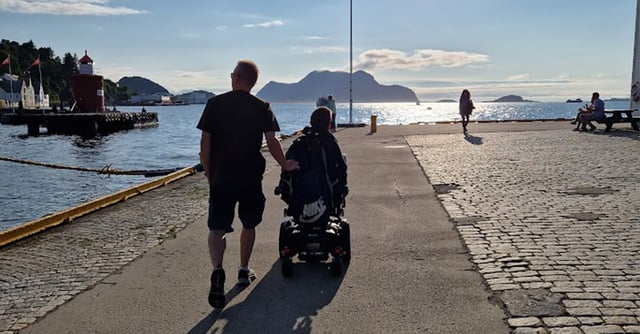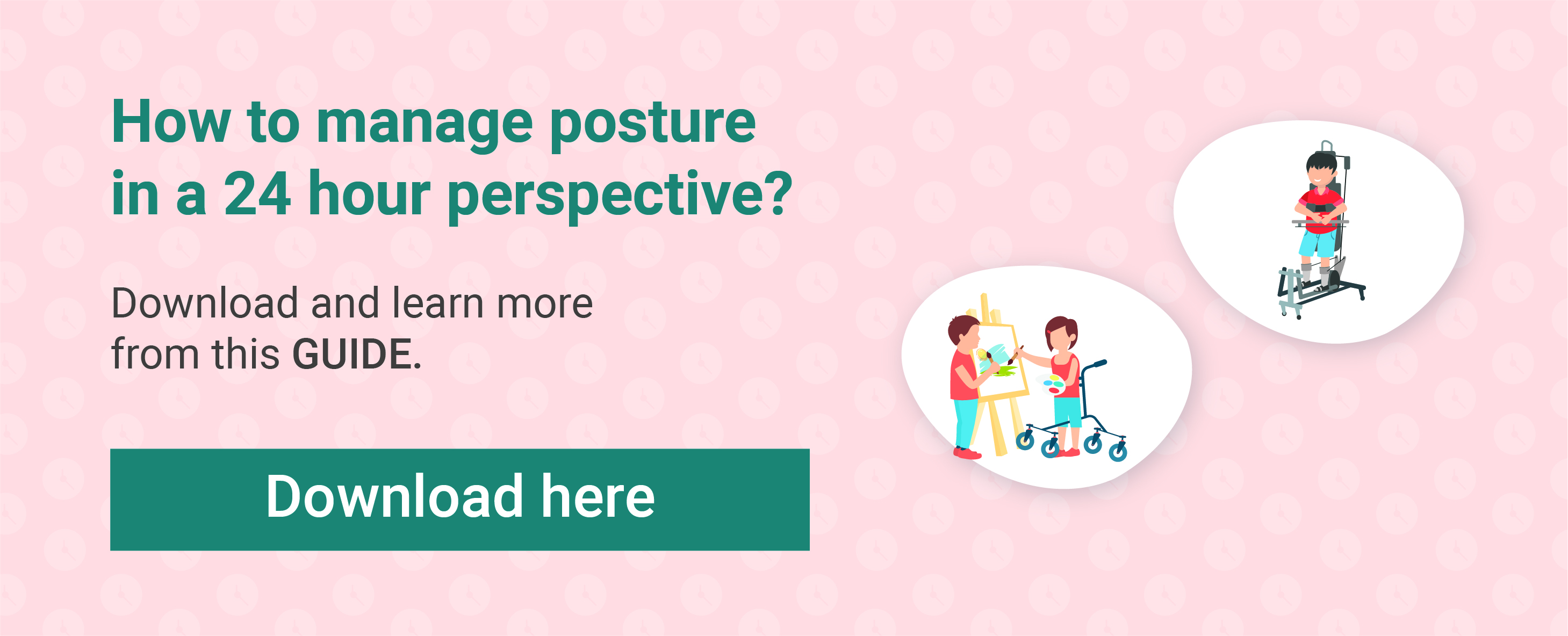
May 13, 2025The Giant Daniel – Life After the Accident

Back to Blog Overview
In 2010, Karina and Magnus experienced every parent's worst nightmare. Their three-year-old son Daniel was found lifeless at the playground in nursery and suffered a severe brain injury. The family's life was changed forever.
In this article, you can read Daniel's story:
- The accident that changed life forever
- The milestone of January 1st, 2011
- Innowalk as early intervention
- Returning home, 7 months after the accident
- Adulthood – A New Era
- Activity is important for everyone!
- Effects of Innowalk
The accident that changed life forever
On October 4th, 2010, the day started like any other for Daniel and his family. Magnus, Daniel's father, met Daniel's gaze through the nursery window and waved "goodbye" as he usually did when dropping him off. No one knew that this day would change their lives forever. Later that day, the parents received the fateful call informing them that Daniel had been involved in a severe accident at the nursery and that they needed to go to the hospital immediately.
Nothing could prepare his parents for what they encountered when they arrived at the hospital in Ålesund, Norway. Daniel had been without oxygen for a prolonged period after he got caught with a skipping rope around his neck on a covered slide. He was on a ventilator with many tubes and wires connected to his little body. At that point, no one knew if Daniel would survive.
Daniel's body temperature was regulated and cooled while he remained in a coma. Therapeutic hypothermia, or controlled cooling, is now an established treatment method; however, in 2010, it was relatively new and infrequently applied to children who had sustained traumatic injuries. The first 14 days after the accident were filled with intense emotions and unbearable decisions for Magnus and Karina. Before Daniel was to be disconnected from the ventilator, they had to consider subsequent actions if Daniel did not breathe independently. Fortunately, they didn't have to face this decision, as Daniel began breathing on his own after 10 days on the ventilator.
The following months were challenging as Daniel experienced severe spasms, was uncomfortable, and had significant pain.
The milestone of January 1st, 2011
At the start of the new year, Daniel's condition began to show improvement. His symptoms became more manageable; he experienced less pain, slept more peacefully, and his spasms decreased. This allowed his parents to finally share moments of eye contact and see their son's warm smile, bringing renewed hope. Subsequently, Daniel was able to visit home for the first time.
Although the immediate danger had passed, the family recognized that their lives had undergone a permanent transformation. Daniel, later affectionately referred to as Giant Daniel by his family, had sustained a severe brain injury, creating uncertainty about his future prospects.
As Daniel's condition stabilized, an intensive rehabilitation program was initiated to facilitate his recovery. This gradually introduced him to various positions, such as sitting and eventually standing.
Innowalk as early intervention
The parents had watched the TV program "The Creator" back in 2007 and witnessed the touching moment when Ånund Olsen won the program with his invention "Innowalk." They never imagined that this assistive device would one day become something they would experience firsthand.
Already in March 2011, Daniel tried Innowalk for the first time. He was still in the hospital, and it was here the trial took place. Karina, Daniel's mother, describes the first trial of Innowalk in her blog:
"I had prepared myself for the possibility that Daniel would probably complain and cry a bit during the fitting and testing of INNOWALK. His left hip is stiff, very stiff (so stiff that he is scheduled for X-ray and ultrasound of it tomorrow, hopefully), stretching his left leg is not easy at all. But this went incredibly well, and Daniel actually seemed content and happy at times. Happy to walk, Daniel?"
After a trial period of 4 weeks, the Innowalk was approved by the national insurance in Norway, and the device became part of his daily training program.

Returning home – 7 months after the accident
In May, seven months after the accident, Daniel was finally able to return home. Daniel is surrounded by many people who love him deeply, and they all do their best to ensure he has a good and dignified life. The home is equipped with assistive devices, and assistants are hired to support Daniel in his daily life. As Daniel grows and his needs change, the house the family lives in gradually becomes too small. Therefore, a process of expanding and adapting the home was initiated.
Adulthood – A New Era
Now, Daniel is 18 years old. His parents describe him as a cheerful and sociable person. He enjoys having people around him and has strong facial expressions that make it easy to interpret his needs and emotions, such as happiness, dissatisfaction, or pain.

Daniel is a wheelchair user and has limited voluntary movement. He requires support to sit and stand and has extensive needs for assistance 24/7. He currently lives at home, but the family is preparing for him to move into his own apartment. This transition marks a significant change in both the parents' and Daniel's lives and necessitates adjustments for everyone involved.
He attends a special educational school and has one year left there. Daniel enjoys music and participates in wheelchair dancing, his preferred weekly activity. He likes speed and enjoys spinning around in his wheelchair. The family engages in outdoor activities, and Daniel takes part in most of them, including fishing, skiing in a sit-ski, and going on trips in the woods and fields in his all-terrain wheelchair.

Activity is important for everyone!
Shortly after the accident, at the age of 3 years, Daniel started using the Innowalk and a standing frame, and to this day, these are still two daily-used devices. It is crucial to maintain good joint mobility in all joints and prevent misalignment so that Daniel can continue to stand as well as sit well-positioned. There are several interventions in place to ensure this. He has a physiotherapist who follows him up twice a week at school and a community physiotherapist who comes once a week. They are also responsible for training Daniel's assistants on how to handle and mobilize him throughout the day. Among other things, there is a routine where Daniel lies on his stomach every day for an hour to ensure a good stretch over his hips.
Every day, he stands in the standing frame at school, and he uses Innowalk at home 7 days a week. On weekends, he often uses the Innowalk two times during the day. Daniel enjoys standing and loves movement. Typically, he uses Innowalk for an hour each time. It has a built-in automatic stop after an hour, and Daniel does not want to get out until it stops by itself.
Innowalk is part of Daniel's daily routine.
He really enjoys standing and moving,
– says Magnus, Daniel's father.

Good routines and focus on positioning within a 24-hour perspective have meant that they have been able to maintain Daniel's joint mobility. He still has full range in both knees and hips, and over 90 degrees in the ankle joint—important parameters for him to continue standing and benefiting from this positioning.
Effects of Innowalk
His parents state that over the past 14 years, Daniel has consistently used the Innowalk device without significant interruptions. They recall only one instance following surgery where he was unable to stand and walk. Magnus and Karina are dedicated to ensuring Daniel remains active, and Innowalk is the sole assistive device enabling him to stand and repetitively move his legs.
The key benefits Daniel experiences from using Innowalk are:
- Movement and activity while standing
- Positive impact on digestive function
- Enhance mucus mobilization
- Maintaining joint mobility in ankles, knees, and hips
- Opportunity for position change
- Increased energy levels
- Muscle stimulation
- Reduction of spasms

Physical activity and movement
are essential for everyone,
– states Karina, Daniel's mother.
We extend our gratitude to Karina and Magnus for sharing their experience with Innowalk. Their narrative, particularly their resilience following such a tragic event, has deeply impressed us. Made for Movement extends its best wishes to Daniel as he enters adulthood.

Rikke Damkjær Moen brings many years of experience as clinical physiotherapist to the Made for Movement team. Her mission is to ensure that everybody, regardless of mobility problems, should be able to experience the joy and health benefits of physical activity. As our Medical Manager, Rikke is passionate about sharing knowledge so that individuals with special needs, families, and clinicians can discover the possibilities and solutions provided by Made for Movement.


